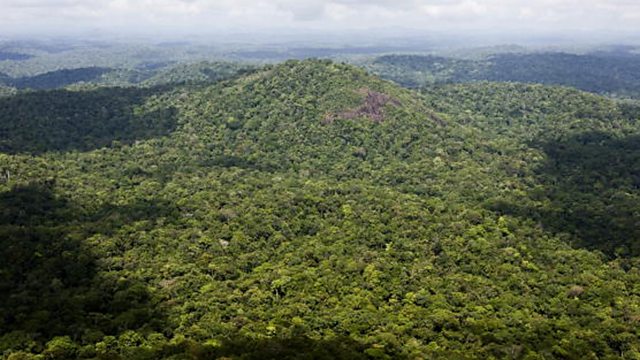19/01/2012
Carbon emissions from Amazon forest; Plant Clinics in Uganda; Glimpses of the very early Universe; Expedition to a dark lake in Antarctica
CARBON EMISSIONS FROM AMAZON FOREST
Normally a forest stores more carbon than it emits.
But looking at the Amazon Basin, Eric Davidson from the Woods Hole Research Center in Falmouth, USA and his colleagues, found preliminary evidence that the Amazon may be transitioning from a carbon sink to a carbon source.
Their research and other work over the last decade shows the effects of climate change and disturbances such as deforestation and fire on the functioning of the Amazon Basin.
Although the Amazon is resilient to individual disturbances, such as drought, multiple disturbances override this resilience.
The effects of global and regional climate change interact with land-use change, logging and fires, increasing the vulnerability of forest ecosystems and leading to degradation.
Eric Davidson is on the programme to explain more.
PLANT CLINICS IN UGANDA
Subsistence agriculture is a method of farming used throughout the developing world, where farmers owning small areas of land grow crops with the main purpose of feeding their families.
As a result a healthy crop can mean the difference between a family that is well fed and one that goes hungry for the rest of the season.
But this way of live is becoming more and more difficult to maintain.
Plant pests and diseases are a major concern as one infestation can wipe out an entire yield of staple crops, such as cassava, in regions like East Africa.
Meera Senthilingam visited South-Eastern Uganda to investigate how one organisation is trying to improve the situation both in East Africa and on a more global scale.
GLIMPSES OF THE VERY EARLY UNIVERSE
Less than half a million years after the Universe was created in the Big Bang 13.7 billion years ago, the fireball cooled to temperatures of about 4000 degrees Celsius, filling the sky with bright, visible light.
As the Universe has expanded that light has faded and moved to microwave wavelengths.
By studying patterns imprinted in that light today, scientists hope to understand the Big Bang and the very early Universe, long before galaxies and stars first formed.
They studied these patterns with the High Frequency Instrument (HFI) on ESA's Planck mission that now has completed its survey and has just run out of coolant.
Jochen Steiner reports on what the Planck satellite has told us so far about the early Universe.
EXPEDITION TO A DARK LAKE IN ANTARCTICA
In October 2011 a team of British engineers embarked on the first phase of a mission to explore what is being called the final frontier of life on earth.
It has taken 15 years of planning and finally they headed to Lake Ellsworth in Antarctica.
But to get there they need to drill through three and a half kilometres of solid ice, which has sealed the lake off from the rest of the earth for the last million years.
In Lake Ellsworth the scientists hope to discover new forms of life.
Now, a team of four engineers has returned to the UK after completing a gruelling journey to put in place equipment and supplies, with enduring temperatures of minus 35Β°C.
One of the engineers involved is Andy Tait from the British Antarctic Survey and he explains what kind of equipment they have transported to Lake Ellsworth.
(Picture: Aerial view of the French Guiana's Amazonia. Credit: AFP)
Last on
Broadcasts
- Thu 19 Jan 2012 19:32GMTΒι¶ΉΤΌΕΔ World Service Online
- Fri 20 Jan 2012 04:32GMTΒι¶ΉΤΌΕΔ World Service Online
- Fri 20 Jan 2012 12:32GMTΒι¶ΉΤΌΕΔ World Service Online
- Sat 21 Jan 2012 06:32GMTΒι¶ΉΤΌΕΔ World Service Online
- Sun 22 Jan 2012 00:32GMTΒι¶ΉΤΌΕΔ World Service Online
Podcast
-
![]()
Science In Action
The Βι¶ΉΤΌΕΔ brings you all the week's science news.


